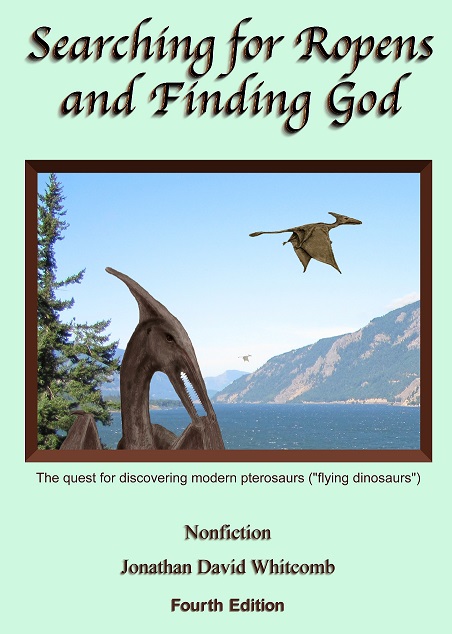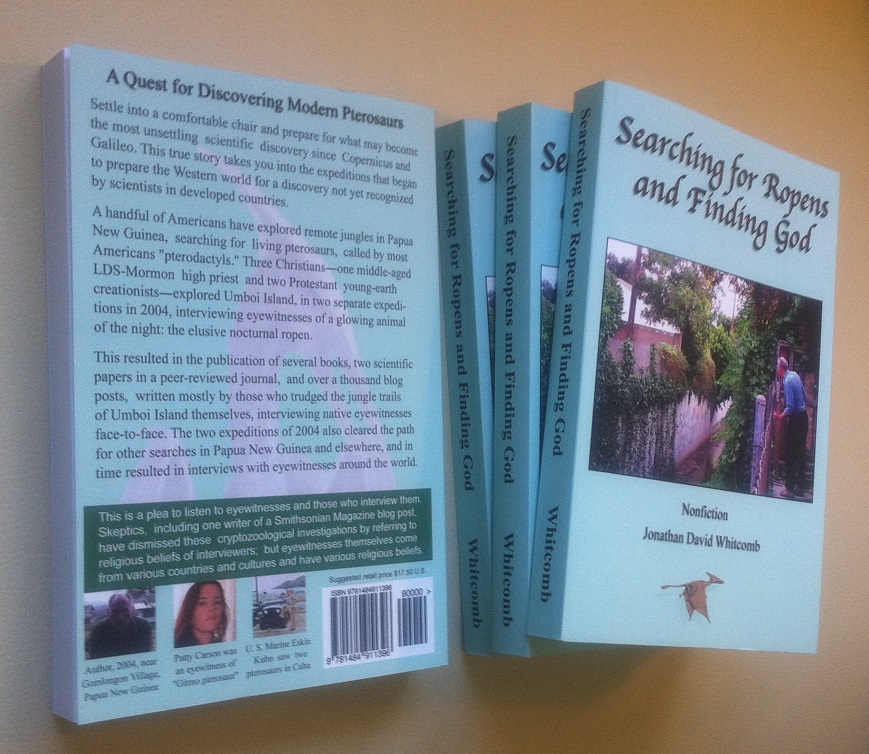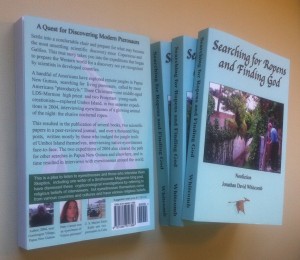How much religion and science are found in the nonfiction Searching for Ropens and Finding God? It depends on what you’re looking for. If it’s quantities of Biblical quotes or complex scientific concepts that prove the Bible is true, this nonfiction would compete poorly with at least two books available on Amazon. But for true-life adventures of Christian explorers who live their faith by getting actively involved, Searching for Ropens and Finding God may be a step above any other book in the religion/science-and-religion genre.
Noah’s Flood
If you look for references to the Flood of Genesis, notice fourteen pages listed in the index. Yet no detailed analysis of geologic strata will you find in this book. The Biblical account is taken as a foundation:
The model of Noah’s Flood suggests that some of them survived into the time of Noah’s descendants, and whatever conditions threatened some species, within several thousand years, some dinosaurs and pterosaurs should have survived. [page 16]
Fiery Flying Serpents in the Old Testament
Look up “fiery flying serpent” in the index and notice four pages on that Biblical animal. Yet no detailed analysis of Hebrew word-meanings will you find. The modern-winged-creature interpretation is explained in simple English:
My associates and I believe that the fiery flying serpent of the Old Testament was a “basal” pterosaur, perhaps related to the long-tailed ropen of Papua New Guinea. We believe they called it “fiery” because of its glow, which we attribute to bioluminescence. “Flying” is literal, with wings. [page 44]
Evolution
Why not look up “evolution” in the index? Seventeen entries you’ll find, but without any obscure scientific words or baffling concepts, mostly just the basics:
Is this a tool for promoting Biblical Creation and ridiculing evolution? Clear thinking we need, without fear, allowing us to discover both truth and error in whatever camp we find ourselves, entrenched or visiting, at the moment. I suggest we beware of simplistic labels. That said, expect explanations for why my associates and I have rejected extreme naturalism philosophy and Darwin’s unlimited common ancestry philosophy, what some call the General Theory of Evolution. [third paragraph of the Introduction, on page 7]
In my childhood, nobody insisted to me that small simple life must have changed into large complex life long ago. I had read of ideas contrary to the General Theory of Evolution by my mid-teens, after our family had moved to Pasadena, California. But I was brought up to believe or disbelieve what I chose. My own feelings, perspective, and belief in God raised my doubts about Darwin. [page 13]
(3rd edition shown above) Searching for Ropens and Finding God – Buy ropen book on Amazon
Science, Mathematics, and Common Ancestry (Unlimited Evolution)
Not all references to scientific investigation are that simple, yet basic explanations of results—that is what you’ll find in this book:
Late in 2002, I began working on what I called an “Evolutionary Boundary.” I wanted to force one step in the evolution of a new biological structure. That would demonstrate how unlikely it would be for all life on this planet to have arisen through evolving from simple organisms in countless steps. It surprised me when my mathematical models failed to produce such a step, even after half a year of work. It proved to me that Darwin’s ideas about the origin of life were even more unrealistic than I had thought.
Conclusions
For those who are offended at ideas contradicting popular standard models in Western science, avoid this book if you don’t want to be offended. For those who want only details that support all Young Earth Creationism ideas, you can be inspired by the faith promoting expeditions of Young Earth Creationists, although only a limited number of the 353 pages directly support a very young earth, and none of them support a young universe.
For those who simply want to know what can fly over our heads at night—you should find this book inspiring, entertaining, and instructive.
###
.
 The most recent edition, number four: Searching for Ropens and Finding God by Whitcomb
The most recent edition, number four: Searching for Ropens and Finding God by Whitcomb
.
If the Israelites had been attacked by an animal well known to us, with a clear label, we would feel no need for oblique interpretations. And if we were always humble enough to admit that our modern science might not include knowledge of every dangerous animal encountered by ancient Israelites, we would feel no need for continuous obliqueness.
.
“Pterosaurs Alive in, Like, the Modern Day”
I’ve written elsewhere about this paleontologist, about his extensive criticism of the concept of modern living pterosaurs (“Pterosaurs alive in, like, the modern day”). His lengthy writings, on that one page, about questionable reports—they ring like strawman arguments to me, for the credible accounts are entirely neglected by Darren Naish.
.
The wingspan was around 30 feet, according to the sailor. The ship was doing target practice at an island in the Pacific. It looked like their ship was found by a Japanese plane, but the men came to realize that it was a flying creature, after it flapped its wings.
.




